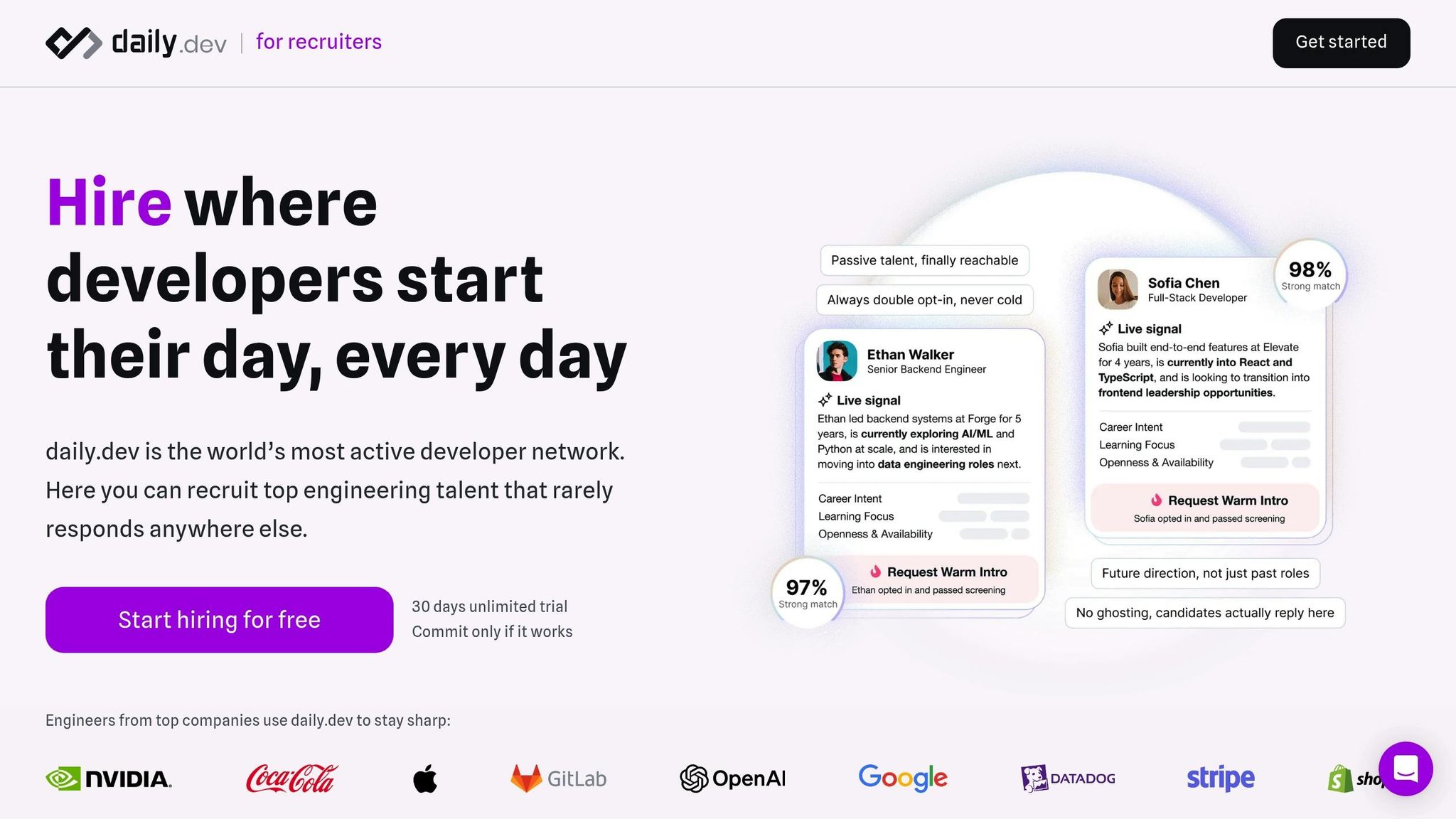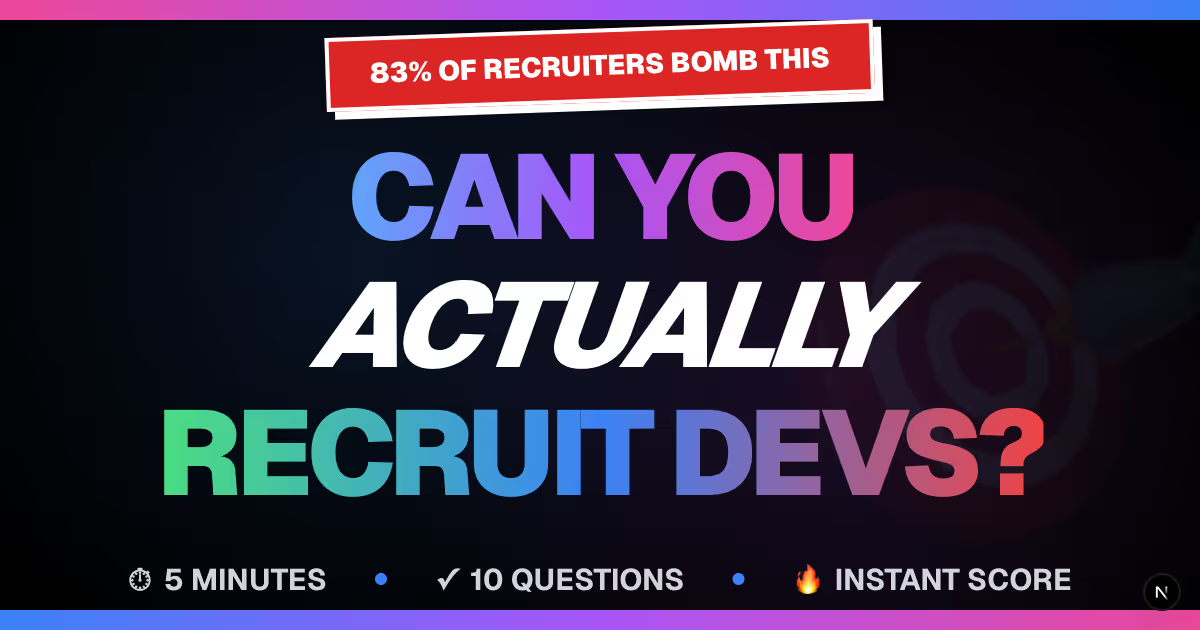


Automated candidate sourcing transforms recruitment by using AI to enhance candidate matching, engagement, and diversity while streamlining the hiring process.
In 2025, hiring skilled developers is more competitive than ever, and manual recruitment methods are falling short. Automated candidate sourcing has emerged as the go-to solution, leveraging AI and data to locate, evaluate, and engage potential hires efficiently. Here's what you need to know:
- What It Is: Automated sourcing uses intelligent software to match candidates' skills with job requirements, assess their interest, and even send personalized outreach messages.
- Why It Matters: Traditional methods are too slow. Automated tools provide faster access to qualified candidates and improve engagement by focusing on tailored communication.
- Key Trends: AI-driven matching, predictive analytics for passive candidates, and personalized outreach are shaping recruitment strategies.
- Key Benefits: Reduced bias, better candidate engagement, and faster hiring processes.
Tools like daily.dev Recruiter excel in this space by connecting companies with a network of over 1 million developers, offering features like double opt-in introductions and dynamic talent pools. Automated sourcing isn't just efficient - it prioritizes meaningful connections, helping recruiters find the right talent while respecting candidates' time and preferences.
How to Automate Recruiting with AI Agents
Core Technologies Behind Automated Candidate Sourcing
Modern automated sourcing relies on cutting-edge technology to find candidates who are a great fit for specific roles. This foundation supports three major advancements in how candidates are sourced and engaged.
AI and Machine Learning in Candidate Matching
Traditional systems often depend on basic keyword searches, which can overlook the finer details that make someone an ideal hire. AI-powered platforms, however, take a deeper dive into candidate data like skills, interests, and career goals. These systems go beyond just scanning for keywords - they analyze context, such as skills gained through side projects or continuous learning. With machine learning, the platforms refine their recommendations over time, learning from feedback to deliver increasingly accurate matches.
Predictive Analytics for Talent Pipelines
Analytics are transforming how recruiters forecast talent availability. Some platforms use predictive analytics to build pipelines of passive candidates - those who aren’t actively job hunting but might be open to opportunities. By tracking how candidates engage with content and participate in discussions, these tools can identify individuals who may be ready for a new role before they start searching. This allows recruiters to establish relationships early, well before a position officially opens.
Automation in Outreach and Engagement
Generic cold outreach - sending the same message to countless candidates - has lost its effectiveness. Automation now makes outreach smarter and more personalized. These systems integrate job opportunities directly into platforms where candidates are already active, tailoring messages based on their skills, interests, and career goals.
One standout feature is the double opt-in introduction process. Instead of recruiters blindly reaching out, candidates review a role first and decide if they want to engage. This turns cold outreach into warm, prequalified conversations. Early data shows that reply rates for double opt-in introductions often exceed 85–90%.
"Every intro comes from a developer who reviewed your role and chose to engage - not someone you had to chase."
- daily.dev Recruiter
Strategies for Effective Automated Candidate Sourcing
Using advanced AI and predictive analytics, automated candidate sourcing has become a powerful tool for refining talent pools and improving engagement methods. To make the most of these systems, it’s essential to focus on building dynamic talent pools, reaching passive candidates effectively, and addressing bias in the hiring process.
Building and Enriching Talent Pools
Automated sourcing tools dive into platforms where developers spend their time - places they go to stay updated on the latest tools, technologies, and trends. These systems don’t just collect static data; they track developer activity over time, creating dynamic profiles that reflect real-time skills and interests.
What sets these systems apart is their ability to go beyond resumes. They monitor what technologies developers are learning, the discussions they’re joining, and how their professional interests evolve. By continuously refreshing profiles, these tools ensure that your talent pool stays relevant and ready to meet current hiring needs.
Engaging Passive Candidates
The best developers often aren’t actively searching for jobs, which makes traditional outreach less effective. Automated systems solve this by presenting opportunities where developers are already active, using a double opt-in process to naturally engage passive candidates.
Here’s how it works: developers first see the full context of a role. If they’re interested, they opt in to learn more, ensuring that any initial communication is based on genuine interest. This approach respects their time while increasing the likelihood of meaningful conversations.
To further streamline the process, custom screening questions can help qualify candidates before direct introductions. This ensures that early discussions are productive and focused on matching the right candidates to the right roles.
Promoting Diversity and Reducing Bias
One of the strengths of automated sourcing is its ability to minimize unconscious bias. By focusing on skills, interests, and career goals, these systems help hiring teams look past factors like university names or company brands that might otherwise influence decisions.
Providing candidates with full role details upfront allows them to self-select, reducing unnecessary screenings and ensuring that only genuinely qualified individuals move forward. Custom screening questions then validate their fit for specific job requirements, while the system provides a complete, unbiased view of each candidate to support informed hiring decisions.
"Trust is the currency of modern recruiting" - Nimrod Kramer, CEO of daily.dev.
Building trust means being transparent at every step and ensuring that all candidates are evaluated fairly based on their qualifications and interests. This approach not only improves the hiring process but also strengthens relationships with potential hires.
sbb-itb-d1e6221
daily.dev Recruiter: A Developer-First Sourcing Platform

Instead of relying on outdated methods like scraping databases and sending cold emails, daily.dev Recruiter connects recruiters directly with a thriving network of over 1,000,000 developers every day. This platform is designed to create a more engaging and trust-based hiring experience by operating within a developer-focused ecosystem.
Developer-First Approach
daily.dev Recruiter operates where developers naturally spend their time - engaging with professional content and staying informed about the latest tools, technologies, and trends. This seamless integration allows job opportunities to appear directly on the platform, avoiding intrusive outreach and fostering trust. Developers who interact with these opportunities are genuinely interested, ensuring a higher quality of engagement. Notably, 40% of the community consists of senior individual contributors and engineering leaders, and 90% of developers engage exclusively on daily.dev.
Key Features and Benefits
Leveraging its unique network, daily.dev Recruiter provides tools that make candidate matching more efficient and developer-friendly. Job descriptions are reimagined as concise briefs that highlight technical challenges and growth opportunities. These opportunities are shown only to developers whose skills, interests, and career goals align with the role. To refine the process further, candidates answer up to three custom screening questions that address specific requirements not included in the public job description. This approach ensures warm, double opt-in introductions - developers review the role details and actively choose to engage.
Streamlining the Hiring Process
The platform integrates with Applicant Tracking Systems (ATS), eliminating the need for manual data entry by automatically deduplicating candidates and routing introduction details. This allows recruiters to make faster, more informed decisions based on detailed candidate insights. Instead of cold outreach, recruiters receive pre-qualified introductions from developers who have already expressed interest. Additionally, they gain access to detailed information about a candidate’s work history, technical interests, and career goals, enabling more meaningful initial conversations. With over 1 billion developer sessions logged on daily.dev, the platform provides unparalleled access to a pool of active and engaged talent that traditional sourcing methods simply can't match.
Best Practices for Automated Sourcing in 2025
To make automated sourcing work effectively, it’s all about balancing legal compliance, creating a positive candidate experience, and tracking performance. By leveraging the right tools and strategies, recruiters can streamline hiring processes while ensuring ethical practices and meaningful engagement with candidates.
Compliance with Data Privacy Regulations
As U.S. data privacy laws continue to evolve, sourcing platforms must prioritize explicit consent and transparency. Simply put, scraping candidate data without their permission isn’t just risky - it’s both legally and ethically questionable.
The solution? Use platforms that rely on active participation from developers instead of passive data harvesting.
"No scraped profiles Developers actively engage on daily.dev every day, giving you access to passive talent you won't find anywhere else."
This model ensures that all candidate data comes directly from individuals who willingly share their information. A double opt-in process, where candidates must explicitly agree before their data is shared, adds an extra layer of security and trust.
Recruiters should seek out tools that avoid scraping altogether, focusing instead on self-provided data. Integrating these tools with Applicant Tracking Systems creates a seamless and secure workflow, keeping compliance at the forefront while setting the stage for a better candidate experience.
Improving the Candidate Experience
Generic outreach is a surefire way to alienate developers and harm your employer brand. Developers expect communication that’s targeted, relevant, and respectful.
The most effective sourcing platforms prioritize contextual engagement over mass messaging. For instance, presenting job opportunities in natural settings - like when developers are reading technical articles or participating in professional development - makes the interaction feel more genuine. By aligning roles with a developer’s skills and interests, recruiters can create introductions that feel warm and personalized, sparking real interest rather than indifference.
Measuring Sourcing Effectiveness
Once compliance and engagement are in place, the next step is tracking metrics to fine-tune your strategy.
- Response rates: High response rates indicate that your targeting and messaging are hitting the mark. Platforms using double opt-in methods often see much better engagement - daily.dev Recruiter, for example, reports reply rates exceeding 85–90% in its early cohorts.
- Time-to-fill: This metric shows how quickly roles are being filled. Automated sourcing should shorten hiring timelines by connecting recruiters with already-interested candidates, reducing the need for lengthy cold outreach.
- Pipeline health: A steady flow of qualified candidates for future openings is a strong indicator of a sustainable sourcing strategy. The goal isn’t just filling current roles but building a robust talent pipeline.
- Quality of hire: Ultimately, the success of sourcing efforts comes down to the performance and retention of new hires, as well as hiring manager satisfaction. These metrics provide a clear picture of whether your strategy is delivering the right results.
Conclusion: Transforming Recruitment with Automation
The way we approach recruitment has undergone a major shift. The manual methods that once got the job done simply can't keep up with the pace and demands of modern tech hiring. Automated tools not only streamline the process but also elevate the experience for candidates.
This shift isn’t just about working faster - it’s about creating genuine connections. Traditional recruiting often feels cold and transactional, which can hurt candidate engagement and even damage an employer's reputation. On the other hand, automated sourcing tools help recruiters build real connections with candidates who are genuinely interested in new opportunities.
Take daily.dev Recruiter as an example. It brings automation into a thriving developer community, making every interaction meaningful and rooted in shared interests. Thanks to its double opt-in process, recruiters only engage with developers who are open to conversations, fostering trust that manual outreach often fails to achieve.
Traditional methods tend to struggle with low response rates, but platforms designed with developers in mind see far better engagement. Why? Because they respect how developers prefer to explore job opportunities - on their terms. This isn’t just about technology; it’s about understanding and valuing the candidate’s perspective.
Looking ahead, the future of recruitment will depend on finding the right balance. The most successful teams will use automation to handle repetitive tasks while keeping the personal touch that candidates value. The goal isn’t to replace human insight but to enhance it - freeing up recruiters to focus on what matters most: building relationships with top talent.
For recruiters, the time to move beyond outdated methods is now. The competitive edge will go to those who combine the speed and precision of automation with thoughtful, respectful engagement. This blend will shape the future of hiring in 2025 and beyond.
FAQs
What makes the double opt-in process more effective for engaging candidates compared to traditional recruitment methods?
The double opt-in process improves how candidates engage by requiring developers to actively confirm their willingness to connect with recruiters before any interaction begins. This method builds trust and guarantees that conversations are purposeful and relevant to both parties.
By doing away with cold outreach, it ensures a more tailored and respectful experience. This not only boosts response rates but also encourages more meaningful exchanges. The process emphasizes genuine interest, making it simpler to establish strong, trust-driven connections with candidates.
What are the key advantages of using AI and machine learning for automated candidate sourcing?
Leveraging AI and machine learning in automated candidate sourcing has reshaped how recruiters find and connect with talent. These tools allow for precise candidate-role matching by analyzing factors like skills, interests, and career aspirations, ensuring candidates are better aligned with the roles they’re being considered for.
On top of that, AI simplifies the hiring process by automating time-consuming tasks such as screening and vetting candidates. This means recruiters can focus more on building relationships and less on repetitive administrative work.
AI also boosts engagement through personalized outreach - tailored messages that resonate with candidates, leading to stronger response rates. What’s more, it opens doors to passive talent pools, reaching individuals who might not be actively job hunting but are open to the right opportunities. This approach not only saves time but also makes the entire process more focused and impactful.
How does automated candidate sourcing promote fairness and reduce bias in hiring?
Automated candidate sourcing prioritizes objectivity by assessing candidates based on their skills, experience, and qualifications. This approach reduces the impact of unconscious biases that might stem from subjective opinions or demographic details.
By concentrating only on relevant factors, automated sourcing supports a hiring process that is both more inclusive and diverse. It allows recruiters to identify top talent while promoting fairness and openness throughout the process.
Related Blog Posts








